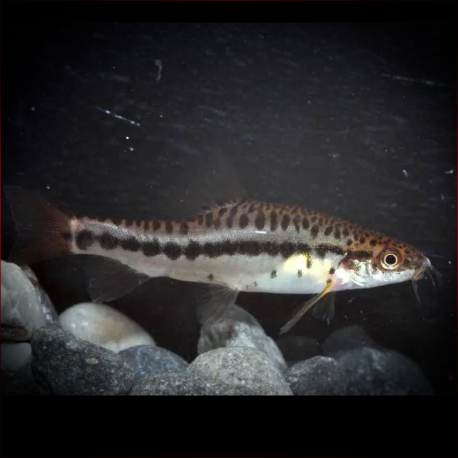More info
Datasheet
| Minimum Tank Size | 80 litres / 21.13 US gallons |
| Maximum Size | 6.0cm / 2.36inches |
| Temperature | 18°C / 64.40°F - 24°C / 75.20°F |
| Hardness | 3.03dgH / 54ppm - 15.02dgH / 268ppm |
| pH | 6.0-8.0 |
General Description
The Inle Loach, scientifically known as Petruichthys Brevis, is a species of loach characterized by its short lateral line with up to 12 pored scales, distinctive cephalic lateral line system, and a range of 16-17 branched caudal-fin rays. Belonging to the Nemacheilidae family, this fish is commonly referred to as the "Lake Inle red-tailed loach." Endemic to isolated Lake Inle in Myanmar, it has a vulnerable status on the IUCN Red List due to habitat deterioration.
Aquarium Setup
To ensure the well-being of the Inle Loach in captivity, it is recommended to maintain them in a planted tank with a capacity of at least 80 litres. A carefully-aquascaped setup, with plenty of live plants, driftwood roots, and leaf litter, is ideal. Additionally, the inclusion of floating plants and fine-leaved aquatic moss can be advantageous if breeding alongside adults. Water conditions should range from a pH of 6.0-8.0, hardness between 54-268ppm, and a temperature of 18-24°C.
Behaviour
This species is known for its peaceful demeanor but may get intimidated or outcompeted for food by larger or more active tankmates. However, when housed with similarly-sized schooling fish, their shyness tends to diminish. Providing suitable hiding spots and a harmonious tank environment can help enhance their comfort levels.
Feeding and Diet
In their natural habitat, Inle Loaches are micropredators that primarily feed on small insects, worms, crustaceans, and zooplankton. In an aquarium setting, they should be offered appropriately sized live foods like small insects and worms. They also accept fine-grade or crushed dried foods. Ensuring a varied and nutritious diet is crucial to their health and vitality.
Reproduction & Dimorphism
Breeding Inle Loaches in captivity has been successful in mature, heavily-decorated community tanks. Females exhibit a more robust build and larger size compared to males. Females display irregular dark spots and blotches, while males possess short vertical bars along their flanks. During breeding, a setup with ample hiding spaces for eggs and fry, such as driftwood roots and live plants, is beneficial.
Habitat and Distribution
The Inle Loach is exclusively found in Lake Inle and its surrounding watershed in Shan state, Myanmar. This region is home to unique biodiversity, including nine fish species and various gastropods. The lake, situated in a karstic valley, boasts clear, shallow waters with a fertile loamy substrate. Factors such as unsustainable agricultural practices and introduction of non-native species have contributed to the species being listed as vulnerable.

